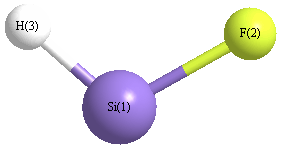Vibrational Frequencies calculated at MP2/aug-cc-pVTZ
| Mode Number |
Symmetry |
Frequency
(cm-1) |
Scaled Frequency
(cm-1) |
IR Intensities
(km mol-1) |
Raman Act
(Å4/u) |
Dep P |
Dep U |
|---|
| 1 |
A' |
2052 |
1955 |
401.41 |
248.34 |
0.35 |
0.52 |
| 2 |
A' |
879 |
838 |
79.09 |
11.83 |
0.40 |
0.58 |
| 3 |
A' |
831 |
792 |
129.03 |
7.04 |
0.71 |
0.83 |
Unscaled Zero Point Vibrational Energy (zpe) 1881.1 cm
-1
Scaled (by 0.9529) Zero Point Vibrational Energy (zpe) 1792.5 cm
-1
See section
III.C.1 List or set vibrational scaling factors
to change the scale factors used here.
See section
III.C.2
Calculate a vibrational scaling factor for a given set of molecules
to determine the least squares best scaling factor.
